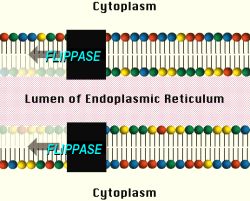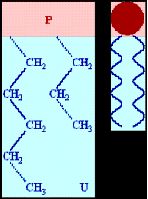 |
Complex Enzyme Machines by Thomas F. Heinze |
|
|
 |
Complex Enzyme Machines by Thomas F. Heinze |
My mind is still out chasing enzymes, those mysterious little protein machines that are usually thought of as catalysts that speed up chemical reactions. I have been eagerly gobbling up the latest fruit of the relative ignorance of the scientific community on these elusive and very individualistic little things. I can now say that enzymes are involved in everything that happens physically in all living things. Equally important is the fact that I can now set your knowledge of them so far back that that you can throw your hands in the air and scream with frustration. Let me set the stage:
 |
Cell membranes are built of two layers of fatty stuff. That’s why a cell membrane is sometimes called a "lipid bilayer," or "phospholipid bilayer." The inside membrane layer lies right against the cell, then there is a space, and then the outside layer.
Image: Phospholipid structure http://commons.wikimedia.org/wiki/Image:Phospholipid_structure.png
|
Each molecule that makes up either bilayer is shaped vaguely like a gooey flexible fat headed thumbtack. The head of the thumbtack is called a leaflet, and these leaflets make up the surface of the membrane itself. The tack part of each leaflet molecule points inward toward the middle of the space between the membranes. It is actually divided into two thin little tails, so my tack analogy was pretty bad.
Now let me introduce you to flippase, an enzyme that lives among these tails in the space between the layers. He does not fit what you think you know about enzymes. He does not hold two or more molecules together in a way that will allow chemical reactions to take place rapidly between them. Flippase is clearly a machine with moving parts that do things, but what we think of as the usual enzyme thing is not the flippase thing. When the cell has built all or part of the first layer of the lipid bilayer membrane, the only layer it can reach, flippase grabs molecules and "flips them" to the layer on the far side. After being flipped the leaflet part of half of the molecules has been moved from the inner to the outer of the bilayers. Without flippase, you don’t get a bilayer, just one layer. Each kind of enzyme is different than the other kinds, but, as you can see, flippase is something else!
Pity your poor friends who have been trying to believe that life is so simple that chemicals just came together and formed life accidentally with no Creator involved! Hopefully the fact that specifically designed enzymes must be there for anything and everything in life to happen will flip them from their dream world into reality. The more they understand, the more they will realize that the cells they thought were simple little bags of goo are actually crammed full of unbelievably complex contents.
"FLIPPASE – Complex Enzyme Machines"
<http://www.creationism.org/heinze/FlippaseEnzyme_en.htm>
|
|